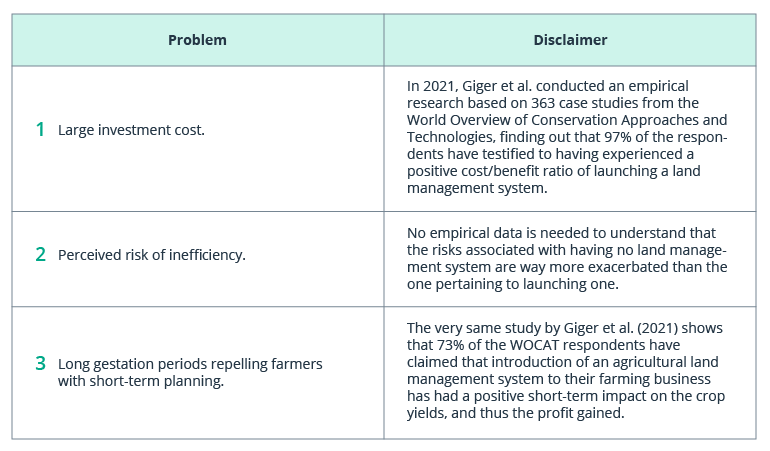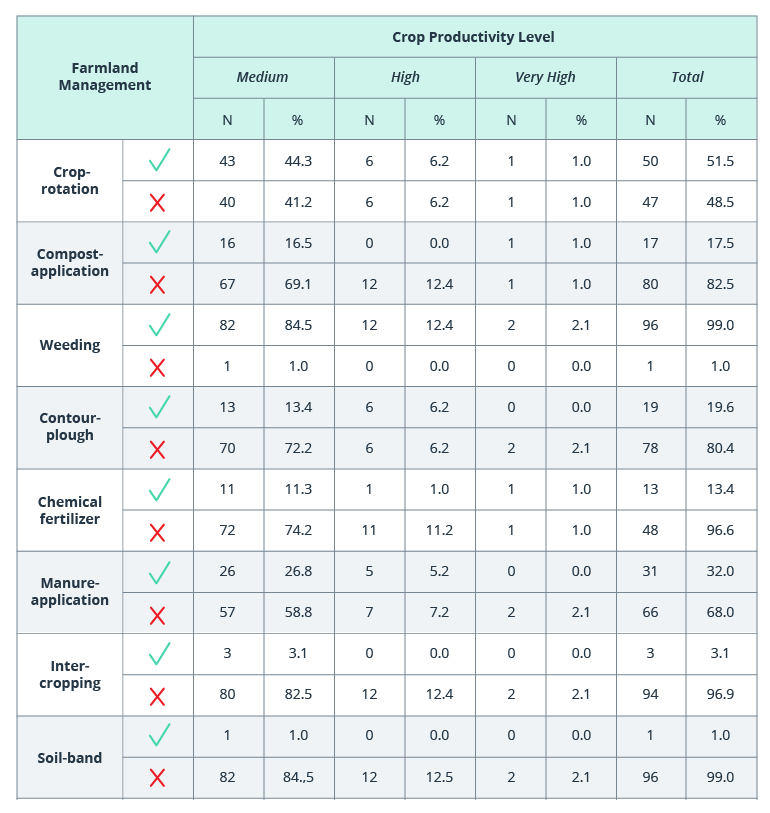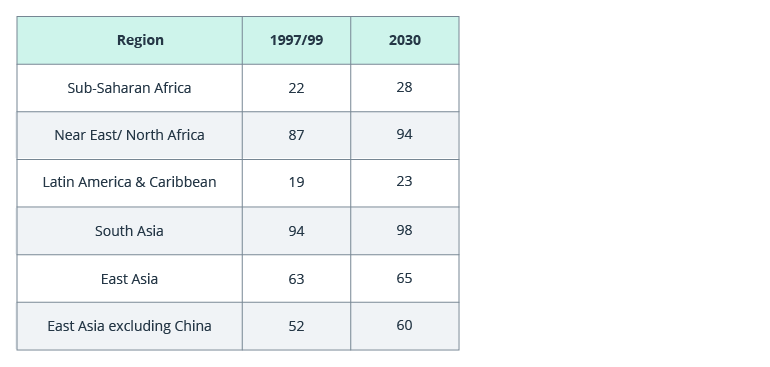What if we told you that the fields of Samarkand in Uzbekistan, the famous silk production capital, are less fertile than the scorching lands of Sub-Saharan Africa. Sounds like a hoax, right? Well, no! It’s merely a consequence of unsustainable land management — in reality, a total lack of agricultural land management practices. We’re not even talking about advanced custom agricultural software, which is used today to first save and then improve farms around the world. Moscow’s reign over the lands of Samarkand during the Soviet times left no healthy field standing. But if a lack of even basic agricultural land management leads to lamentable consequences, what can wise agricultural land management do to your yields and eventually your income? In brief, it will ensure the long-term fertility of your land while ensuring predictable annual crop yields. The extended answer is in the article below. Keep reading to learn about:
- The whats and whys of land use management systems
- Challenges of adopting agricultural land management practices
- Seasonal planning with a land use management system
- Crop production and integrated land management systems
- Land management system software for post-harvest management
- Why agricultural land management systems are not a whim but a necessity
Land use management systems: The whats and whys
Land use management systems a unique combination of software and hardware known collectively as the Internet of Things (here at Intellias, we’ve even come up with our own specialized term — the Internet of Agricultural Things). Sensors, satellites, programs, data centers, and many other components come together to make sure you can plan, produce, and sell your yields efficiently and lucratively, meeting each new season armed.
Nowadays, one of the best examples of sustainable land management practices is the computerization of farmland registers, which enables their linking to geographical information systems. Hence, farmers get a software tool for centralized management of agriculture-related data in a visual and easy-to-understand format. Having a land management strategy in agriculture essentially boils down to one thing: being sure that your company is going to do well and having a plan prepared in advance in case something goes wrong.
Challenges of adopting agricultural land management practices
There are a lot of opponents of land information management systems claiming that the challenges of land management are insurmountable. The challenges are certainly there. In fact, challenges are everywhere when it comes to agriculture, and every farmer knows that. A farming process that goes smoothly from start to finish happens… never.
However, the average farm can actually face more serious problems than the challenges of land management, including unsustainable food processing and tilling and harvesting practices that reduce the lucrativeness of the enterprise. According to the Climate Technology Centre & Network, there are three pivotal challenges farmers encounter when launching a land management system.
Challenges of adopting a land management system

Basically, these challenges boil down to fear of risk. Today’s agricultural land management systems are custom-built around customers’ requirements and field parameters. They are science-driven systems that farmers plan, implement, and benefit from.
On the other hand, one can follow the style of the Soviet government, who approached the lands of Central Asia with the “after me, the deluge” principle. As per Wad JRC Europe, today’s Kyrgyzstan, Uzbekistan, Turkmenistan, and Kazakhstan suffer the consequences of practices such as monocropping, excessive irrigation without adequate drainage, tillage on steep slopes, overgrazing of pastures, deforestation, and inadequate replenishment of soil fertility — everything that refined land management system features would have prevented from happening. It seems like the right time to talk about how agricultural land management can help farmers increase yields with data-driven planning, precision-based processing, and targeted distribution and logistics.
Seasonal planning with a land use management system
What is the ultimate goal of seasonal planning in agriculture? Sure enough, it’s making sure that your harvest lives up to your expectations. Nonetheless, there is one more beautiful thing about season-long planning: it can prevent land degradation, which is the fiercest enemy of any farmer. According to the Food and Agriculture Organization of the United Nations, efficient agricultural land management has turned Kenya into one of the world’s leading black tea producers, while Mali and Guinea are gradually becoming the world’s rice leaders.
How exactly does crop land management help you with planning a season of ample yields that is not threatened by unexpected turmoil? Well, land use management systems were considered something out of this world before the advent of IoT and advanced farm management software. Land use management systems offer four major tools that bring four crucial deliverables.
Agricultural land management system’s informational output during crop production

There are a plethora of other methods, technologies, and tools involved in gathering meteorological and geospatial data within a unified agricultural land management system. As you can see, the amount and types of information they can provide let you decide in advance on many important matters, especially when, where, and what to plant. Yet the most important deliverable you can get from land management systems is a detailed set of signs showing you what needs to be done to preserve and maximize yields and to sell your harvest successfully at the end of the season.
Crop production and integrated land management systems
Having an integrated land management system can help you mitigate diseases and manage pests efficiently, which is the primary mission of every farm over the course of the growing season. Once you’re done with season planning, your major task is to sustain the crop until it reaches the harvesting phase. If you’re wondering how land management system software can help you cope with this mission, we have the answer.
As we’ve already mentioned, agricultural land management systems work with the help of a geographic information system (GIS), which makes a farmer’s life a hundred times easier. A GIS land management system collects data with the help of IoT sensors and satellite images. As a result, the FAO says that such systems become capable of:
- Detecting infected areas with the help of sensory and imagery data
- Maintaining regular quantitative assessments of the pest–disease balance
- Applying disease and pest forecasting techniques where needed
- Defining and applying crop–cultivar combinations that minimize the chemical pressure and maximize natural prevention of pests and diseases
- Advising on the storage and use of agrochemicals in accordance with legal requirements
- Assuring the storage and application of agrochemicals is carried out by specially trained personnel
- Avoiding impacting non-target areas
- Avoiding any kind of pollution resulting from the use, storage, and disposal of agrochemical products
- Ensuring that equipment is used in accordance with safety standards
- Providing machinery automation, application, and management tools and practices
- Short- and long-term farm productivity planning in terms of fighting diseases and pests
An integrated land management system seems to cover all matters related to disease and pest prevention and management. The system prevents farmers from wasting time while inspecting fields manually. It automates the detection process, then regulates and manages chemical storage, application, and disposal, meaning that a farmer can fight pests and diseases with targeted actions. As a result, farmers save money and timeyields remain as expected.
Research by Kebede Darge, Guyu Ferede, and Temesgen Soresa, who gathered statistical information from 142 farming households in Jima Geneti, Ethiopia, serves as vivid proof of the impact that land management system features have on agriculture. In fact, it shows that applying rudimentary practices is not enough today. Here is a table that showcases the nexus of farm management practices and crop yield production.
The nexus between crop productivity and farmland management practices

Source: ResearchGate — Nexus
The results clearly show that the effects of applying agricultural land management ranged from a 0.10% to a 10% increase in yields, which is quite impressive given the rudimentary type of land management practices applied. Now, let’s look at what sufficient agricultural land management can do on a larger scale. Below is a table showing predicted changes in the percentage of arable lands in various regions of the world that have been extensively applying agricultural land management practices.
Arable land in use as % of potentially arable land

Source: UNStats — Statistics of Land Use
It is clear that applying extensive land management practices helps farms exterminate pests and overcome diseases, thus delivering on their contractual obligations and supplying yield volumes as stipulated.
Agriculture Software Development
Act fast and beat your competitors even before the agricultural race begins with our custom agricultural software development services. Built with precision and attention to every detail, our solutions make sure you use your data smartly and efficiently.
Land management software for post-harvest management
Let’s look more closely at the advantages of agricultural land management, which is one of the most important yet underestimated phases in the annual lifecycle of any farm. According to Prithviraj et al. (2020), the main objective of post-harvest management, which involves systematic techniques and processes for harvesting, shipment, storage, processing, packaging, and preservation, is to “reduce the loss or wastage of agricultural products and increase shelf life.” Yet the problem is that farms that are not using farm land management services often leave behind seeds, husks, molasses, stems, roots, and other materials in fields, all of which have high levels of nitrogen, phosphorus, and potassium that could be recycled to ensure sustainable farming.
Below is a graphical representation of a farming process aimed at ensuring the largest yield volumes while maximizing sustainability.
Timeline: Pre-processing to post-harvesting

Source: ResearchGate
All in all, there are three major missions that a land information management system can help you deal with in the post-harvest stage: warehousing, traceability, and logistics. Let’s have a closer look at them.
Warehousing
It’s important to apply the very best warehousing practices, as this is the key to preventing loss of harvested crops. If you still doubt how warehousing may affect your crop volumes, just think about the loss a farm inflicts on itself by not keeping its harvest fresh and thus good for selling. Losing money you should have earned prevents you from having the funds for starting a new harvesting cycle.
Traceability
Keeping a close watch on your fields following the harvest is critical to avoid unpleasant surprises when a new season starts. Traceability is one of the most crucial advantages of agricultural land management, as it lets you define the flow of your production, processing, and distribution. With traceability, a farm can make wiser decisions on the crops to produce the next season based on the market success of a particular yield. Furthermore, traceability enables your fields to meet the next season in perfect condition, saving a lot of money. For example, a lack of post-harvesting surveillance results in a 15% to 30% decrease in agricultural productivity in Rwanda, as it does in most other countries.
Logistics
Let’s consider the story of Hinga Weze, a USAID-funded project that forever changed the life of Kumwe Harvest Ltd., a Rwandan maize grower and producer.
The company’s story was told on Angrilinks, and it amazed many people. Kumwe Harvest Ltd. received training on GIS land management systems and land management systems software from Hinga Weze, a USAID-funded organization. As a result of implementing the newly presented practices, they managed to increase their yield by 50%, from three tons per hectare to four and a half tons per hectare. What is even more important is that the land management system was Kumwe’s ticket to entering the cooperative of aggregators, where they were able to negotiate prices from $400 to $600 per ton. Furthermore, having a budgetary land management system, they’ve managed to:
- Increase productivity by reducing the amount of time farmers spend processing their harvest from six weeks to three days. The five and a half weeks saved now can be spent on other proactive activities, such as preparing fields for the next season.
- Faster payments to farmers: Now farmers can receive their payment for the sold crop within one to two days, meaning they can reinvest money into farming.
- Improved access to market: The land management system enables small farms to use the cob model, letting them enter high-end markets full of national-scale buyers, resulting in increased income.
Agricultural land management system: Not a whim but a necessity
Having a land management strategy in agriculture these days is as important as having the machinery you need for tilling and harvesting. Establishing an efficient crop land management system is all about taking proper care of your farm’s future. Our ancestors used the land without thinking in advance, perceiving it as a non-finite resource that would keep on giving without asking for anything in return. Today, treating land with the care and respect it deserves is the very least we can do to ensure a sustainable future for ourselves and our offspring.
Planning farming seasons while understanding the yield capacity of your own farm, calculating expected crop volumes, dealing with issues during harvesting, and making sure that land will be ready to produce even more the next year is what our farm land management services are all about. An agricultural land management system can help you establish lucrative operations in the long-term perspective while refining methods for profit maximization.
Intellias is a trusted agricultural software developer for dozens of satisfied customers around the world. We’re ready to build the solution your land needs, and we are ready to implement it when you are. Drop us a line and we’ll contact you at a convenient time.

